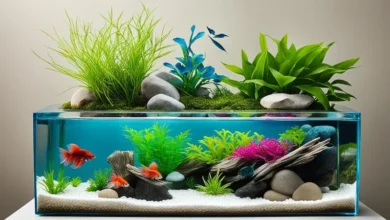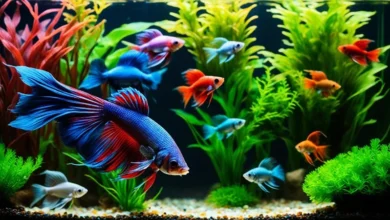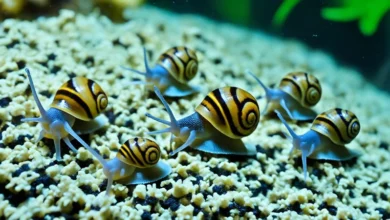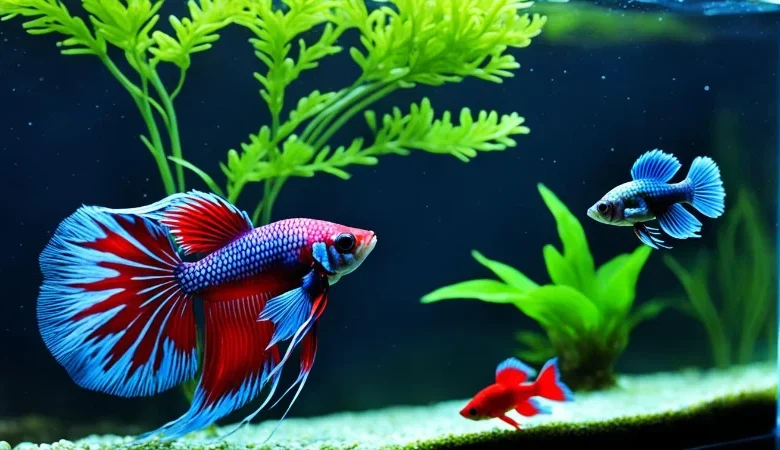
Have you ever wondered if Betta fish and Cherry shrimp can live together in the same aquarium? Many aquarists are curious about this dynamic pairing. Betta fish are known for their carnivorous instincts and might hunt shrimp, but the rapid breeding of Cherry shrimp can sustain their population even if some fry are eaten.
The key to their compatibility lies in understanding the unpredictable nature of Betta fish. Some Betta fish may ignore adult shrimp, while others could be aggressive. Successful cohabitation involves careful planning: maintain a pH of around 7, keep the temperature between 75-80°F, and ensure the tank has plenty of space and hiding spots.
Despite the complexities, there are mutual benefits to housing Betta fish with Cherry shrimp. Bettas can benefit from the occasional live food, reducing boredom and behavioral issues, while Cherry shrimp help clean the tank by eating leftover food and algae, maintaining a healthier environment.
Introduction to Betta Fish and Shrimp
Exploring the compatibility of Siamese Fighting Fish and Neocaridina davidi in a shared aquarium setting gives us fascinating insights into the dynamics between these locally treasured aquarium species. Many enthusiasts hope for peaceful coexistence within nano tanks, but to achieve this, understanding both species is crucial.
What Are Betta Fish?
Betta fish, or Siamese Fighting Fish, are known for their vibrant colors and striking fins. These freshwater fish are territorial and can be aggressive. In the wild, they live in shallow waters like rice paddies and slow-moving streams in Southeast Asia. Their carnivorous diet includes small invertebrates like shrimp, making their aquarium compatibility a debated topic.
What Are Cherry Shrimp?
Cherry shrimp (Neocaridina davidi) are popular among aquarists for their vibrant colors and cleaning habits. They breed quickly, maintaining their population in tanks with Betta fish. As scavengers, they feed on algae and detritus, aiding in tank maintenance. With proper management, they can coexist peacefully in community tanks, making them ideal for mixed-species aquariums.
Understanding the Compatibility Issue
The main challenge in keeping Betta fish and Cherry Shrimp together is the predatory nature of Bettas. Some Bettas may ignore adult shrimp, while others might hunt them. To increase compatibility, maintain a pH around 7, a temperature between 75-80°F, and provide plenty of hiding spaces with plants and decorations.
Betta Fish Predatory Behavior
The behavior of Betta fish towards tank mates, especially invertebrates like Cherry shrimp, highlights their natural carnivorous diet and predatory instincts. Understanding these traits is crucial for managing potential aggression in an aquarium setting.
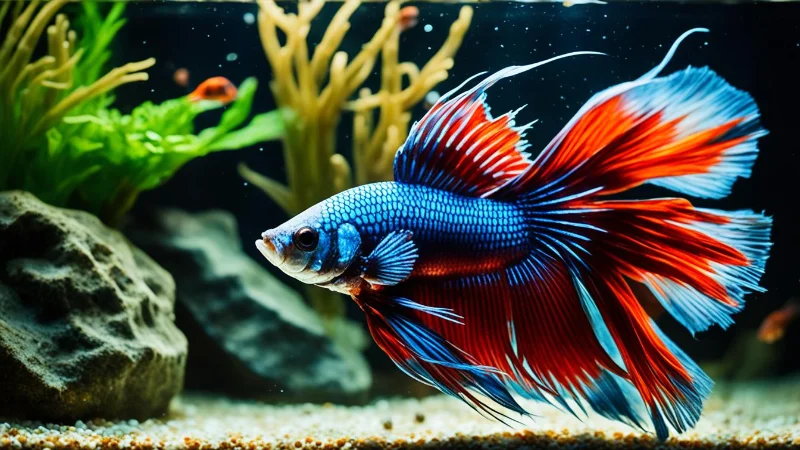
Natural Diet of Betta Fish
Betta fish, or Siamese fighting fish, are natural carnivores, feeding on small invertebrates, insects, and larvae in the wild. This diet means Cherry shrimp are seen as prey. While adding shrimp to the tank every few months can help maintain their population, Betta fish will always pose a risk to these tiny crustaceans.
Betta Fish Temperament
Introducing juvenile bettas into a tank with Cherry shrimp is often recommended due to the variability in Betta fish temperament. Some Bettas may coexist peacefully with shrimp, while others may show aggression. A 5-gallon tank with up to 50 shrimp can minimize confrontations, and larger tanks with more vegetation can further reduce the chances of Betta attacks.
Regularly observing interactions and being ready to make adjustments is key to maintaining a balanced and peaceful aquarium environment.
Benefits of Keeping Shrimp with Betta Fish
Introducing Cherry shrimp to a Betta fish tank offers numerous benefits, as these shrimp are excellent members of an aquarium clean-up crew. Here’s why they can be a great addition:
- Improved Water Quality: Cherry shrimp consume leftover food, decaying plant matter, and algae, which helps maintain water quality and prevents dangerous fluctuations in water parameters, creating a more stable environment.
- Rapid Breeding: As Neocaridina species, Cherry shrimp breed quickly once they reach adulthood. This ensures a stable population even with occasional predation by Betta fish.
- Detritus Consumption: Cherry shrimp continuously feed on debris, dead plant matter, and detritus, contributing significantly to the cleanliness and health of the tank.
- Natural Enrichment for Bettas: While Betta fish may occasionally chase the shrimp, this activity can keep them engaged and reduce boredom, preventing undesirable behaviors like fin biting.
- Ease of Care: Cherry shrimp are generally low-maintenance when it comes to water parameters, making them a popular choice for creating a balanced aquatic ecosystem. Both Cherry shrimp and Betta fish thrive in a pH level of 7 and a temperature range of 75-80°F, simplifying the management of a harmonious tank environment.
- Aesthetic and Functional Benefits: Adding Cherry shrimp not only enhances the tank’s visual appeal but also ensures a well-rounded habitat where all inhabitants can thrive.
By understanding and leveraging these benefits, aquarists can create a dynamic and peaceful tank environment for both Betta fish and Cherry shrimp.
Challenges of Keeping Shrimp with Betta Fish
Maintaining a harmonious aquarium with Betta fish and shrimp can be challenging due to Betta fish predation. Betta fish are natural carnivores and often prey on smaller invertebrates, including shrimp fry. This predatory behavior can significantly threaten shrimp populations.
Risk of Predation
The risk of predation by Betta fish is a significant concern when keeping shrimp in the same aquarium. While some Bettas may peacefully coexist with shrimp, others might aggressively hunt them. This behavior varies among individual Betta fish, so it’s crucial to observe their temperament before introducing new shrimp.
Water Parameter Sensitivities
Shrimp are highly sensitive to water quality, making it crucial to maintain optimal conditions for their well-being. They thrive with a pH level of 6.5-7.5 and a temperature range of 75-80°F (24-27°C). Additionally, keeping ammonia and nitrate levels at 0 ppm, general hardness (gH) at 3-4 dGH, and carbonate hardness (kH) at 3-5 dKH is essential to minimize stress and reduce mortality rates among shrimp.
Using tools like a TDS (Total Dissolved Solids) meter, which is affordable at around $15, can help monitor water conditions and support shrimp breeding.
Creating an environment with ample hiding spots is also important. Providing decorations, plants, and hiding spots helps shrimp feel safe, especially during molting, and reduces the likelihood of conflict with Bettas. Strategically placing these elements within the tank enhances the chances of survival and peaceful coexistence.
Choosing the Right Tank Size
Choosing the right aquarium size is crucial for maintaining a harmonious environment for Betta fish and Cherry shrimp. A minimum tank size of 5 gallons is recommended, with a 10-gallon tank being ideal for better coexistence.
Key points to consider:
- Tank Size: A larger tank helps stabilize water parameters and provides ample space for shrimp to evade Betta fish.
- Breeding Rates: Cherry shrimp breed rapidly, so a small tank can quickly become overcrowded.
- Stocking Levels: A 2-gallon tank can house 2-3 ghost or Cherry shrimp due to their low bioload, but regular water changes are essential to maintain water quality.
- Hiding Places: Incorporate plants, driftwood, and décor to create hiding spots, which help mimic their natural habitat and reduce stress.
By providing a spacious environment and considering the rapid breeding of Cherry shrimp, you enhance the chances of peaceful coexistence between Betta fish and shrimp.
Setting Up a Betta Fish and Shrimp Tank
Proper tank setup is crucial for fostering peaceful coexistence between Betta fish and shrimp. From ensuring optimal water conditions to thoughtfully designing the habitat, every detail matters. Let’s dive into the essentials for creating a thriving, harmonious environment for both species.
Optimal Water Parameters
Maintaining ideal water parameters is crucial for the health of Betta fish and shrimp. Aim for a pH around 7 and a temperature between 75-80°F, as these conditions suit both species. Additionally, keep ammonia and nitrate levels at 0 ppm, with a general hardness (gH) of 3-4 dGH and a carbonate hardness (kH) of 3-5 dKH to ensure a healthy environment.
Creating Hiding Spaces
Incorporating plenty of hiding spots in the tank is crucial for shrimp safety, especially during molting. Adding shrimp hides and artificial caves provides essential refuge and reduces the stress from potential Betta predation. Introducing the shrimp before the Betta can help establish a balanced environment.
Plant and Decoration Choices
Selecting the right mix of aquatic plants and tank decor is crucial for a harmonious Betta and shrimp tank. Incorporate plenty of aquatic plants like Java moss, Anubias, and floating plants to mimic natural habitats and provide coverage for shrimp. Diverse tank decor offers surfaces for biofilm, essential for shrimp nutrition.
Feeding Betta Fish and Shrimp
Feeding Betta fish and Cherry shrimp in a shared tank requires careful planning to ensure both species receive proper nutrition. Here are some key strategies:
- Betta Diet: Bettas are carnivorous and need high-protein foods like pellets, flakes, and live or frozen options such as bloodworms.
- Shrimp Diet: Cherry shrimp thrive on biofilm, algae, and plant detritus, essential for their nutrition.
- Multiple Feeding Locations: Place Betta food near the tank’s surface and sink foods like algae wafers or shrimp pellets at the bottom. This minimizes competition and ensures both species get their needed nutrients.
- Natural Supplementation: Adding driftwood and live plants promotes biofilm growth, supporting the shrimp’s dietary needs and maintaining a balanced aquarium diet.
Cherry shrimp breed rapidly, allowing their population to sustain itself even if some fry is occasionally picked off by Bettas. Consistent food supply for both species helps maintain a healthy shrimp population and satisfies the Betta’s predatory instincts.
By incorporating these strategies, you can create a harmonious environment where both Betta fish and Cherry shrimp thrive.
Betta Fish and Shrimp: Other Compatible Shrimp Species
When looking to add diversity to a Betta tank, exploring different shrimp varieties can be rewarding. It’s essential to select species that are less likely to become prey while enhancing the tank’s ecosystem.
Types That Might Work
Besides Cherry shrimp, Amano shrimp and certain types of Ghost shrimp can coexist successfully with Betta fish. Amano shrimp are larger and more robust, making them less likely targets due to their size and agility. Ghost shrimp, known for their speed, can often evade a Betta’s predatory instincts. Both types help keep the tank clean by consuming algae and adding an interesting dynamic to the aquarium.
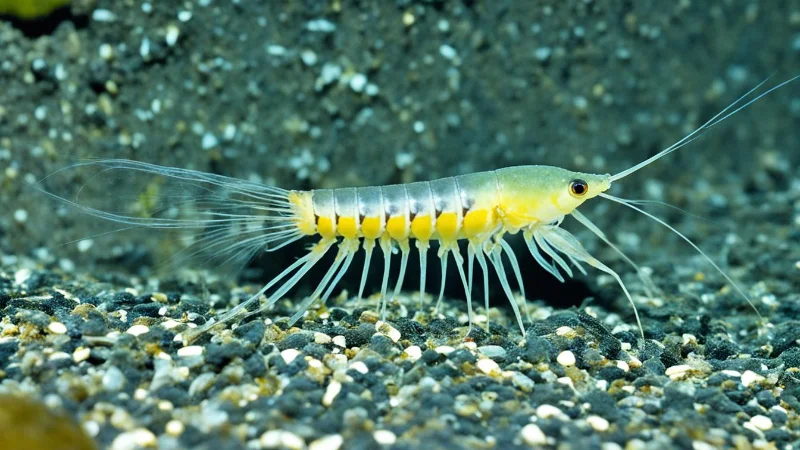
Species to Avoid
Certain shrimp species should be avoided when housing with Betta fish. Neocaridina shrimp, like Crystal Red Shrimp, are delicate and may not thrive due to their slower breeding rates and fragile exoskeletons. Bamboo shrimp, though interesting, rely on filter-feeding and are too gentle for a tank with Bettas. Choosing the right shrimp varieties is crucial for creating a harmonious and thriving aquatic environment.
Observing Betta Fish and Shrimp Interactions
Regular aquarium observation allows me to monitor the interactions between Betta fish and shrimp. It becomes a crucial step to ensure peaceful tank dynamics and to identify any early signs of aggression or excessive predation.
Out of 7 replies in the forum, 2 shared personal experiences of introducing cherry shrimp to betta tanks resulting in the deaths of the shrimp due to aggression from the betta.
Several users, including myself, have concluded that behavior monitoring can vary based on the method of introduction. One approach is to acclimate the shrimp alone first before reintroducing the betta. Another involves placing the shrimp directly into the tank to observe their initial interactions.
In one case, a user mentioned starting with three cherry shrimp in a 9-gallon tank, resulting in all three shrimp being killed by the betta. This highlights the importance of having an alternative plan, like a separate tank, readily available. Ghost shrimp or Amano shrimp are often recommended as better companions for bettas, which I agree with based on their better survival odds.
- An increase in tank size or adding more plants can reduce predatory behavior.
- Bettas may react differently based on the chronological introduction of the shrimp.
- A well-fed betta is less likely to hunt shrimps compared to a hungry one.
- Individual betta personalities can significantly influence their behavior towards shrimp.
Keeping my betta well-fed also helps taper its predatory instincts, fostering a more harmonious predator-prey relationship. Although varied opinions exist, many users caution against mixing cherry shrimp and bettas, suggesting alternatives for better peaceful tank dynamics.
Regular Cleaning and Maintenance Tips
Maintaining a healthy tank for Betta fish and Cherry shrimp involves several key practices. Here’s a simple guide to ensure a thriving aquatic environment:
- Regular Water Changes: Perform 20-30% water changes weekly to remove excess waste and toxins. This helps keep the water clean and stable.
- Cleaning Substrate and Decorations: Use a gravel vacuum to remove detritus and uneaten food from the substrate. Rinse filter media in tank water (not tap water) to preserve beneficial bacteria essential for shrimp health.
- Monitoring Water Parameters: Bettas prefer neutral pH and warmer water, while Cherry shrimp thrive in slightly cooler temperatures and can tolerate minor pH fluctuations. Use a high-quality water conditioner and beneficial bacteria supplements like Seachem Stability to maintain balance.
- Adding Plants and Decorations: Incorporate plenty of plants and decorations to provide hiding spots and encourage natural behaviors. Plants also help maintain water quality by absorbing nitrates.
By diligently monitoring and maintaining these conditions, you can create a harmonious and healthy environment for both Betta fish and Cherry shrimp. This approach ensures their well-being and fosters peaceful coexistence.
Conclusion
In conclusion, achieving a harmonious coexistence between Betta fish and Cherry shrimp is possible but requires careful planning and attention. Since Betta fish are naturally predatory, they may prey on smaller shrimp, so it’s essential to monitor their behavior closely to ensure the shrimp population isn’t significantly reduced. The rapid breeding rate of Cherry shrimp can help maintain their numbers even if some are eaten.
